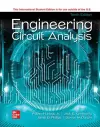
Engineering Circuit Analysis ISE
4 authors - Paperback
£58.99
Dr. Sheila Bailey was a senior scientist in the Photovoltaics and Electrochemical Systems Branch at NASA Glenn Research Center, where she has worked from 1985-2018. She received her Bachelor’s (Duke) and Master’s (UNC) degrees in Physics and her Ph.D. in Solid State Physics (Univ. of Manchester, UK). She taught at Baldwin Wallace University for 27 years and has been an associate faculty member of the International Space University. Dr. Bailey’s PV work has centered around advanced etching, epitaxial lift off and quantum dot (QD) solar cells. She is co-author of over 150 publications in various aspects of solar cell materials processing and applications for space exploration. She has also authored numerous chapters in books and co-edited several books on this topic. She serves on editorial boards of several PV journals as a space PV expert. Aloysius F. Hepp earned a PhD in Inorganic Photochemistry in 1983 from MIT. He retired in December 2016 from the Photovoltaic & Electrochemical Systems Branch of the NASA Glenn Research Center. Dr. Hepp has co-authored nearly 200 publications (including six patents) focused on processing of thin film and nanomaterials for I-III-VI solar cells, Li-ion batteries, integrated power devices and flight experiments, and precursors and spray pyrolysis deposition of sulfides and carbon nanotubes. He has co-edited twelve books on advanced materials processing, energy conversion and electronics, biomimicry and aerospace technologies. He is currently Editor-in-Chief Emeritus of Materials Science in Semiconductor Processing (MSSP) and is currently the chair of the International Advisory Board of MSSP, as well as serving on the Editorial Advisory Boards of Mater. Sci. and Engin. B and Heliyon - all Elsevier journals. Dale C. Ferguson received the Ph.D. degree from The University of Arizona, Tucson, in 1974. He is currently the Lead for Spacecraft Charging Science and Technology with the Space Vehicles Division, Air Force Research Laboratory (AFRL), Kirtland Air Force Base, Albuquerque, NM. For nearly 40 years, he has been addressing spacecraft charging problems, first with the NASA and now with AFRL. He is the author of more than 200 publications. He has been the Principal Investigator on numerous spaceflight experiments, including the Wheel Abrasion Experiment on the Mars Pathfinder Sojourner Rover. Ryne P. Raffaelle (RPR) earned both a BS and MS in Physics from Southern Illinois University and a Ph.D. in Physics from Missouri University of Science and Technology. He is the Vice President for Research and Associate Provost at Rochester Institute of Technology (RIT). He is the former Director of the National Center for Photovoltaics at the National Renewable Energy Lab of the U.S. Department of Energy. Prior to serving at NREL, he was the Academic Director for the Golisano Institute for Sustainability and Director of the NanoPower Research Laboratory at RIT. He has worked as a visiting scientist at the NASA Glenn Research Center, NASA Kennedy Research Center, and DOE’s Oak Ridge National Laboratory. He is the author of over 200 refereed publications. He is on the Advisory Board of Elsevier’s Materials Science in Semiconductor Processing and is the Managing Editor of Progress in Photovoltaics, published by Wiley Interscience. He is the co-editor of several books on photovoltaics and nanotechnologies. Steven Durbin received the BS, MS, and PhD degrees in Electrical Engineering from Purdue University. Prior to joining Western Michigan University in 2013, he taught at the Florida State University, the University of Canterbury (New Zealand), and the University at Buffalo (SUNY). He is a senior member of the IEEE, and a member of the American Physical Society, the Materials Research Society, and the Royal Society of New Zealand. His interests include novel semiconductors, oxide and nitride compounds, molecular beam epitaxy, pulsed laser deposition, and Schottky contact based devices and have resulted in > 150 publications. Prof. Durbin is currently Editor-in-Chief of Materials Science in Semiconductor Processing since 2016.